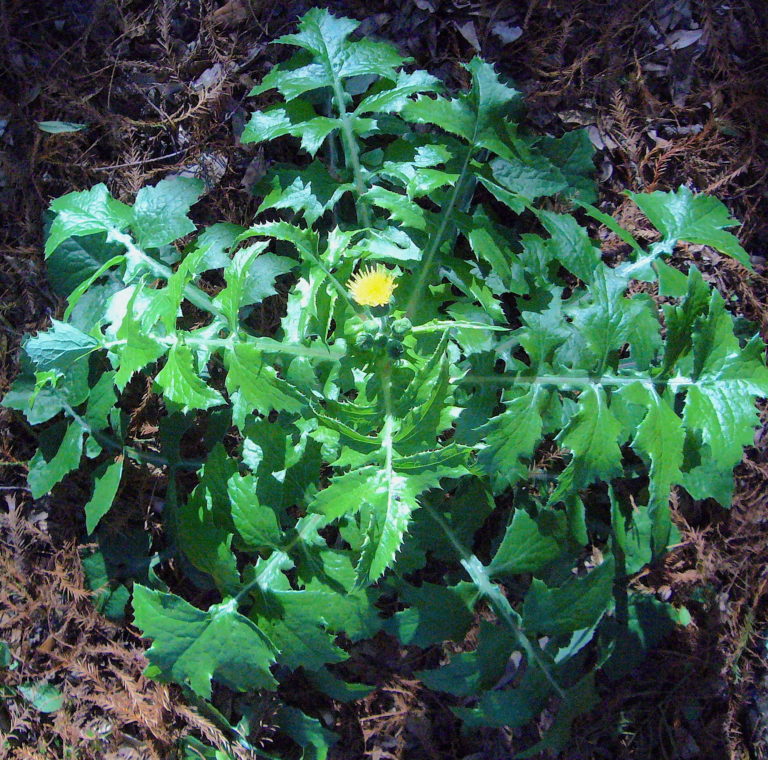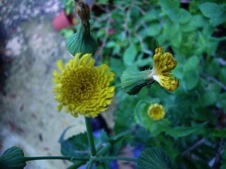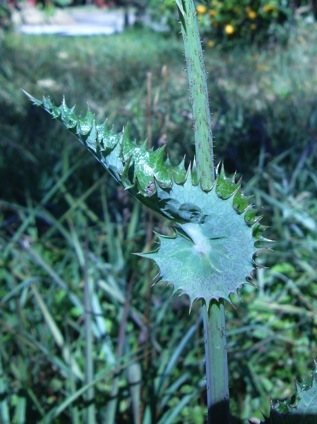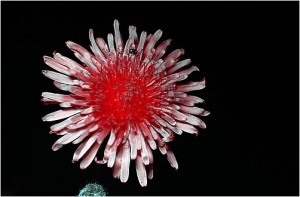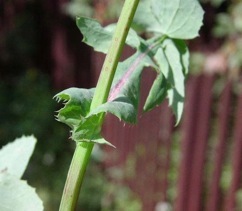Sonchus: Sow Thistle, In A Pig’s Eye
Starting in mid-January in Florida, later north of here, two of three local species of sow thistles invade my lawn in great number. They are so good they’re worth all the complaints about my untraditional lawn. I can’t eat them fast enough. In fact, right now I am having a bowl with homemade butter, salt and pepper. I threw a couple of plants that were a little too old into the pot but they weren’t too bitter. That bitterness is caused by their white sap.
You cannot eat most plants with white sap (or white berries.) That is one of the general rules of foraging for wild food, besides that and never eating anything wild without positive identification and verification it is edible. There are three or four common exceptions to the white sap rule: Figs, Ground Nuts, Sow thistles and various Wild Lettuce.
There’s a huge variety in sow thistles, from having few or no prickles to having a lot, from a foot high to six feet high, from green to purple, especially older plants. Young sow thistles can just be tossed in the herb pot, where as some older leaves need to be trimmed of the thistles, which is a point of culinary departure. Really old leaves are bitter and not that much fun to eat even if they are edible. Frankly if you have to trim spines off sow thistles you’re better off leaving them alone. Young and tender leaves is a good rule to follow particularly with the rougher species. When young their flavor resembles lettuce and as they age more like Swiss chard. When old they are just bitter. I try to harvest them between four and 12 inches high. The young stalks peel and cooked are excellent, too. The young root is also edible when cooked but tends to be woody.
The three common ones are Sonchus oleraceus, (SON-kus oh-ler-AY-see-us ) Sonchus Asper (SON-kus ASS-pur) and Sonchus arvensis (SON-kus ar-VEN-sis.) They are respectfully the common sow thistle, the spiny sow thistle and the field sow thistle. The Oleraceus has green leaves with a bit of blue, Delta- arrow-shaped end lobes and distinctly pointed lobes where it clasps the stem. The asper has spiny round lobes where it clasps the stem. It also has a lot of spines. It’s the one that can require trimming. The arvensis has more lance shaped leaves, lobes can be irregular, and soft small spines. It is the softest of the three with a tactile feel closer to a wild lettuce.
As for the sow thistle’s botanical name: Sonchus is the ancient Greek name for the plant and means “hollow” referring to the plant’s hollow stem, a point of identification. Although grazing animals (and butterflies) actually prefer the Sonchus to grass farmers rant about the plant because it’s a weed amongst their crop. It is sad to say but a lot of agri-business is not green, or perhaps not so in the United States. In southern Italy Sonchus invades crops there but they have the good sense to pick it and serve it with spaghetti. Oleraceus means it is edible or cultivated. Asper means rough, and arvensis of the cultivated field.
Sow thistles got their name because they were fed to lactating pigs. (Remember the old heuristic way of thinking? If you want to see like a hawk eat hawk eyes. If you want mama pigs to nurse better feed them plants with white sap.) Anyway, the white sap of the thistle was assumed to be good for nursing sows. As it turned out, pigs love them, as do rabbits which is why they are sometimes called Hare Thistles (they are not true thistles, however, which is another genus altogether. True thistles always draw blood their spines are so sharp. You can read about them here. )
As you can assume, sow thistle is found literally around the world. In Greece, it is used in winter salads, and has been for thousands of years. Pliny wrote that before Theseus went to meet the Bull of Marathon, he was treated by the old woman Hecale (e-KAH-lee in Greek) to a dish of sow thistles. The ancients Greeks considered sow thistle wholesome and strengthening — maybe the Bull of Marathon should have eaten some. Modern Greeks call it Zohos. In New Zealand, Sonchus is called “puha” and is frequently eaten, particularly by the Māori who also used the sap as a gum. A very nice blog on the Māori and the Sonchus can be read here.
Again, young and tender is usually better when it comes to cooking wild greens. Here are some sow thistle recipes from ‘The Essential Hedgerow and Wayside Cookbook’. Incidentally, young Sonchus asper may seem prickly when raw but its soften when cooked (unless you picked them way to old.)
BUTTERED SOW-THISTLE
1 or 2 handfuls sow-thistle leaves – young
Butter or oil
Beef stock or water
Ground nutmeg – pinch
1 tsp. flour
Salt and pepper
For this recipe the young 2- to 4-inch leaves of common sow-thistle
[Sonchus oleraceus] are best and when the leaves are not bitter.
Other sow-thistle species may need their spines trimming off and
may be bitter to the taste requiring some preparatory boiling.
Heat some butter or oil in a pan and add the leaves. Stir thoroughly to
coat the leaves. Add a good slug of stock or water, reduce the heat to a
simmer and cover. Cook for about 5 to 10 minutes. Add a pinch of nutmeg,
the flour and some seasoning. Stir everything, then add another knob of
butter and melt into the sow-thistle over a low heat.
Serve.
STIR-FRIED SOW-THISTLE & PORK
½-1 cup pork meat – shredded / sliced
Light soy sauce
Corn flour – pinch
Water
White wine or dry sherry
Sugar – pinch
Salt and pepper
Sows thistles
Begin by slicing the meat into pieces about 2 inches long and 1/10th inch thick. Set aside. Next, make up a marinade from the remainder of the first group of ingredients, using a splash of soy sauce, slugs of water and wine, seasoning and pinches of corn flour and sugar. Mix together well in a bowl and then add the sliced meat. Stir thoroughly so that all the pieces are
coated and leave for 30 minutes. Heat some oil in a frying pan and fry the ginger for a couple of minutes, stirring to prevent burning, then add the spring onion. Stir for a minute, then add the meat. Stir-fry until the meat begins to cook. Add the sow-thistle leaves and continue frying for another 3 or 4 minutes, stirring to prevent burning and distribute the heat.
Green Deane’s “Itemized” Plant Profile
IDENTIFICATION: Plants have milky sap. S. Oleraceus tall with stemless lobed leaves that point past the stem. S. asper prickly-edged stem-less green leaves that wrap around the stem, dandelion-like blossoms more or less arranged in a flat top manner. S. arvenis similar to both but can be very tall.
TIME OF YEAR: In northern climates spring, summer and some times autumn, in the South December through April.
ENVIRONMENT: Lawns, fields, vacant lots, waste areas, parks
METHOD OF PREPARATION: Young leaves in salads, tend to be bitter, older leaves boiled for 10/15 minutes.

